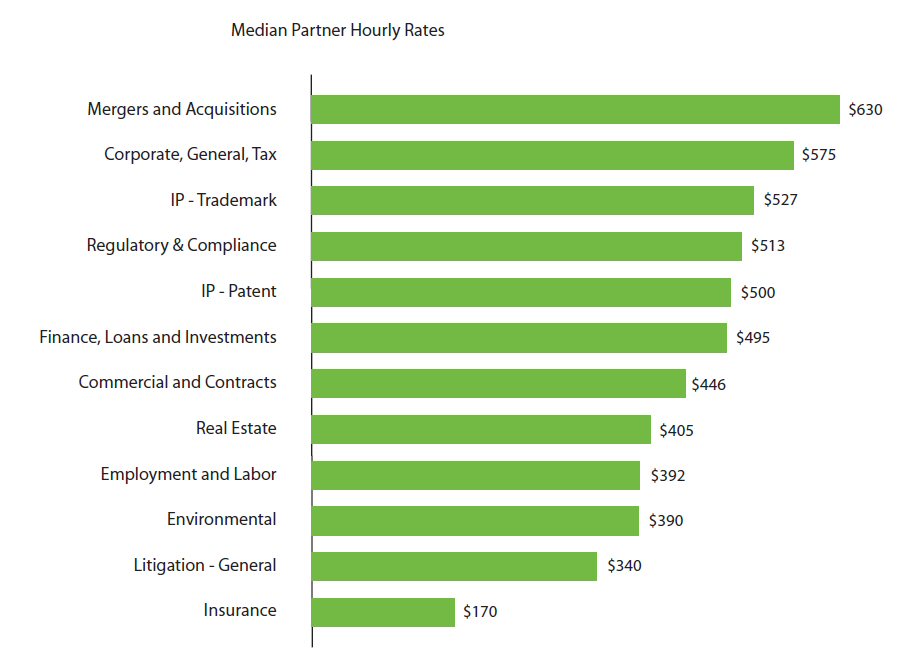 Lawyers are smart people. Most lawyers have attended presentations on how to develop new business and enhance their practices. As a result, most of them clearly understand the theory behind business development. Most of them sincerely want to get more work and better work.
Lawyers are smart people. Most lawyers have attended presentations on how to develop new business and enhance their practices. As a result, most of them clearly understand the theory behind business development. Most of them sincerely want to get more work and better work.
So, why do most lawyers fail to achieve their business development goals?
The two primary obstacles are fear and lack of time. Fear is generated when lawyers are asked to step outside of their comfort zones and engage in new activities. Lack of time causes lawyers to push business development to the back burner, never giving it the chance to mature into habit.
“The best way to overcome these obstacles is to develop a customized marketing plan and tactics that fit a lawyer’s unique personality (thus overcoming fear),” said Craig Brown, “and to develop good business development habits (using a pipeline) that keep these activities front-and-center.”
Brown discussed how to motivate lawyers to engage in business development at the monthly educational meeting of the Rocky Mountain Chapter of the Legal Marketing Association, held Sept. 10 at Sullivan’s Steakhouse in LoDo Denver. Brown is a former lawyer and principal consultant with LawVision as well as founder of the Motivera Group and Modena Seminars.
“Lawyers will be successful when they are comfortable with and get satisfaction from business development, and when they develop the habit of regular engagement in business development activities,” said Brown.
Lawyers are not “designed” to sell
The average lawyer who is asked to sell differs from the average sales professional in many important ways. In a well-known study, Dr. Larry Richards used the Caliper Profile to discover the personality traits common to various successful professionals – including lawyers.
Richards uncovered certain personality traits that set lawyers apart from non-lawyers. Lawyers score high on abstract reasoning (82 percent), which is no surprise.
Richards found that lawyers score high on skepticism (90 percent), autonomy (89 percent) and urgency (71 percent). “The skeptical lawyer will question everything; the autonomous lawyer will resist being managed; and the urgent lawyer will be impatient and want to see immediate results,” said Brown. “None of these qualities is particularly helpful when it comes to business development.”
Richards also found that lawyers score low on sociability (7 percent) and resilience (30 percent). “Lawyers with low sociability scores are reluctant to open up their personal lives to others,” said Brown. “They play it close to the vest. The less-resilient lawyer is unable to bounce back easily from criticism or rejection. These qualities hinder lawyer efforts at business development.”
In a related study, Richards focused on lawyers in particular -- comparing a group of lawyers, all rated as excellent lawyers by their peers, who differed only in their business development skills.
“The biggest differentiators between the rainmakers and less successful lawyers were ‘ego drive’ and ‘resilience,’” said Brown. “Ego drive is the desire to persuade others for the sheer joy of getting someone else to agree with them.”
Resilience is the ability to bounce back from criticism or rejection. When a prospect says ‘no,’ a lawyer with low resilience takes the rejection personally and wants to quit. A lawyer with strong resilience feels challenged and just wants to try harder.
“Lawyers as a group differ from other professionals in their personality traits,” said Brown. “Plus, lawyers who are successful rainmakers differ considerably from lawyers who are not. This does not mean that lawyers as a group cannot be effective rainmakers. They need to be aware of their natural tendencies, discover what works for them, and then work harder at it.”
No “one size fits all”
“Business developers who work in roles that are consistent with their personality, values and interpersonal characteristics are more likely to outperform those who are less well-matched,” said Brown. “It is important to match lawyers with business development activities that fall within their comfort zones.”
To do this, Brown developed a tool called the Lawyer Behavior Profile. “This tool is a personal GPS for building a lawyer’s practice,” said Brown. “It is objective, designed specifically for lawyers and focused specifically on business development traits. Its goal is to help lawyers best deploy their strengths and work around their weaknesses in the business development process.”
The Lawyer Behavior Profile is a deep-dive assessment that Brown’s company administers to its clients.
Quick Tool to Understand Prospects
In addition, Brown shared a shorthand tool devised for quickly understanding and categorizing the personalities of prospects.
This tool charts each person on two characteristics – orientation and speed. A person’s orientation can be towards tasks or towards people, or somewhere in between. A person’s speed can be methodical or quick, or somewhere in between. Plotting these elements on two axes generates four quadrants and four distinct personality types.
People who are methodical and task-oriented are “analyzers.” To analyzers, it is important to “get it right.” They pay attention to details, are systematic and analytical, and are problem solvers. Common career choices for analyzers are scientist, engineer, accountant, ERISA attorney or IP attorney.
“When trying to persuade an analyzer to engage in business development activities,” said Brown, “use facts, numbers and information. When trying to get an analyzer to do business development, let them use information to persuade. Research projects and articles that can be shared with clients and potential clients are good activities for analyzers.”
People who are methodical and people-oriented are relators. To relators, it is important to “get along.” They are agreeable, need to be liked, interested in others and often serve as peace-keepers. Common career choices for relators are counselors, teachers, ministers, social workers and arbitrators.
“When trying to persuade a relator to engage in business development activities,” said Brown, “emphasize activities that maximize interaction – events where they can meet people and create relationships. Networking (including social networking) is a good business development activity for relators.”
People who are quick and task-oriented are directors. To directors, it is important to “get it done.” They are focused, direct and blunt. They need to be in control. Common career choices for directors are CEO, drill sergeant, dictator, athletic coach and managing partner.
“When trying to persuade a director to engage in business development activities,” said Brown, “emphasize activities where they can be in control. Board leadership or organizing a seminar (but not necessarily speaking at the seminar) is a good business development activity for a director.”
People who are quick and people-oriented are performers. To performers, it is important to “get appreciation.” They are creative individuals who see the “big picture” rather than the details. They enjoy opportunities to socialize and be recognized. Common career choices for performers are sales person, entertainer, social director, advertising executive and trial lawyer.
“When trying to persuade a performer to engage in business development activities,” said Brown, “emphasize activities that allow them to be creative in public. Giving speeches and making presentations at a beauty contest are good business development activities for performers.”
Build habits using a pipeline
Once you have found the best match between a lawyer’s personality and business development activities, the challenge becomes time. The best way to overcome the obstacle of time is to develop solid habits that become part of a lawyer’s regular routine.
“The best tool to accomplish this goal is the pipeline,” said Brown. “Pipelines provide organization, prompt next steps, track conversations and next steps, analyze networks, and help lawyers move from credibility and awareness (lower-level goals) to relationships (higher-level goals). Many lawyers like the analytical approach and structure of a pipeline.”
A pipeline is simply a list of qualified prospects that a lawyer would like to transform into clients – and a system that tracks exactly where a lawyer is in the process and the next step that needs to be taken. A sales pipeline is a system to organize, motivate and direct a lawyer’s sales activities – in the shortest amount of time.
A pipeline begins with a chart that includes the name of the target entity; the target contact within the entity; target revenue numbers; information, history and notes about the contact; next steps to be taken; and deadlines to be met.
An important part of the pipeline is the stage of the relationship. There are seven stages: (1) target identified, (2) initial communication made, (3) steps taken to build relationship, (4) meeting held to assess legal needs, (5) steps taken to build trust, (6) agreement to hire and (7) file opened.
Analyze pipeline stages
“Ideally, to keep a pipeline flowing, a third of these targeted contacts should be in the first few states, a third in the middle stages and a third in the final states,” said Brown.
“A lawyer with a lot of targets in the first stages is good at meeting people, but needs to concentrate on transforming awareness into productive relationships,” said Brown. “A lawyer with most targets in the middle stages needs to learn about closing the deal. A lawyer with most targets in the final stages needs to worry about the pipeline running dry once that work is done.
“At stages three and five (building relationships and building trust), pursue activities that include your targets,” said Brown. If you are giving a presentation or a seminar, for example, ask your target to be a co-presenter. If you are writing an article, ask your target to be co-author, or send your targets a copy with a nice note. If you are hosting an event, invite your targets to attend.
“Finally, when meeting with a target, a lawyer should try to discover the target’s personality type and modify his or her approach to better match the client’s personality,” said Brown. “Use a Google search to learn more about the target. Do a LinkedIn exercise to discover common connections.
“Check out the target’s office space,” said Brown. “Analyzers will be surrounded by stacks of documents and magazines. Relators often will have a lot of pictures of family, friends and colleagues in their offices. The offices of directors will usually be Spartan. Performers will entertain interruptions, like phone calls and text messages, during your meeting. They will prominently display any awards.”
Once you understand a lawyer’s unique personality type, you can decrease their fear of marketing by coming up with a plan and tactics that meet their comfort level. Once they are comfortable with the tactics, you can address a lawyer’s perceived lack of time by devising a pipeline. Spending just 30-60 minutes a week on pipeline activities can develop the essential habit of business development.
 Author Bio: Janet Ellen Raasch is a writer, ghostwriter, copyeditor and blogger at Constant Content Blog who works closely with professional services providers – especially lawyers, law firms, legal consultants and legal organizations – to help them achieve name recognition and new business through publication of newsworthy and keyword-rich content for the web and social media sites as well as articles and books for print. She can be reached at (303) 399-5041 or jeraasch@msn.com.
Author Bio: Janet Ellen Raasch is a writer, ghostwriter, copyeditor and blogger at Constant Content Blog who works closely with professional services providers – especially lawyers, law firms, legal consultants and legal organizations – to help them achieve name recognition and new business through publication of newsworthy and keyword-rich content for the web and social media sites as well as articles and books for print. She can be reached at (303) 399-5041 or jeraasch@msn.com.
.jpg)
.jpg) Larry Bodine is a journalist, lawyer and business development advisor to law firms. He is currently pursuing a project to publish legal news for consumers in newspapers, TV stations and web sites. For more information, you can reach him at 520.577.9759 and larrybodine.com.
Larry Bodine is a journalist, lawyer and business development advisor to law firms. He is currently pursuing a project to publish legal news for consumers in newspapers, TV stations and web sites. For more information, you can reach him at 520.577.9759 and larrybodine.com..jpg)

 Larry Bodine is a journalist, lawyer and business development advisor to law firms. He is currently pursuing a project to publish legal news for consumers in newspapers, TV stations and web sites. For more information, you can reach him at 520.577.9759 and larrybodine.com.
Larry Bodine is a journalist, lawyer and business development advisor to law firms. He is currently pursuing a project to publish legal news for consumers in newspapers, TV stations and web sites. For more information, you can reach him at 520.577.9759 and larrybodine.com.  Lawyers are smart people. Most lawyers have attended presentations on how to develop new business and enhance their practices. As a result, most of them clearly understand the theory behind business development. Most of them sincerely want to get more work and better work.
Lawyers are smart people. Most lawyers have attended presentations on how to develop new business and enhance their practices. As a result, most of them clearly understand the theory behind business development. Most of them sincerely want to get more work and better work. Author Bio:
Author Bio:  Each month, we highlight upcoming events, anniversaries, holidays and observances that have a legal connection. These occasions may help inspire blogging topics. And because relevant online searches can spike in the days leading up to these events, topical blog posts may yield higher-than-normal traffic, while also improving your website's search engine rankings.
Each month, we highlight upcoming events, anniversaries, holidays and observances that have a legal connection. These occasions may help inspire blogging topics. And because relevant online searches can spike in the days leading up to these events, topical blog posts may yield higher-than-normal traffic, while also improving your website's search engine rankings. Author Bio:
Author Bio:






